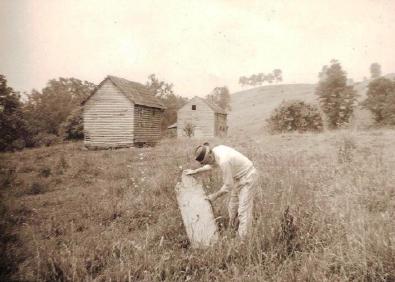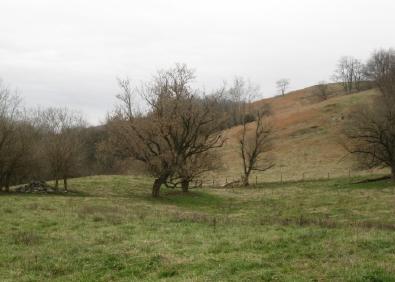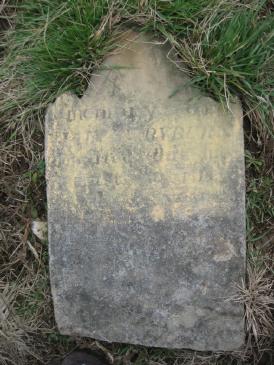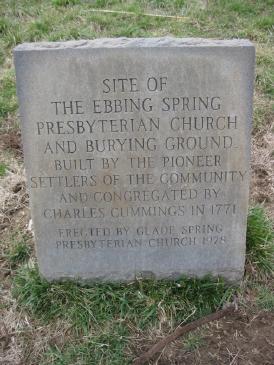Ebbing Spring Church and Cemetery
Many of Washington (then Fincastle) County’s earliest settlers were of the Presbyterian faith. In the late 1760s and early 1770s families began to gather for worship. Two meeting houses were constructed, one at Sinking Spring (now Abingdon) and one at Ebbing Spring on the Middle Fork of the Holston River. Ebbing Spring Church was built on a gentle hill a short distance above the spring. Members of both congregations joined forces and extended a call to the Rev. Charles Cummings who at that time was an established preacher at North Mountain Church in Augusta County. The petition was signed by 138 individuals representing 120 families.
Rev. Cummings answered the call and from 1773 to 1780 preached at both Sinking Spring and Ebbing Spring churches. The territory experienced ongoing Indian attacks during these years and the men, including Rev. Cummings, came to church with their rifles at their side. Many men in the congregation fought at Pt. Pleasant, Kings Mountain and elsewhere. When their days were done they and their families were buried at Ebbing Spring Cemetery.
The photo on the right was taken in late 2011 by Charlie Barnette. The buildings are gone but the stones on the very far left of the photo by the trees may be from the foundation of the Stump home.
The Ebbing Spring Congregation obtained a treasury warrant for the 122 acres surrounding the Meeting House and Cemetery. The land was surveyed in 1788 but the congregation did not secure a grant for the land. Instead they assigned their interest in the 122 acres to John Scott, who received a formal grant for the land in 1796. The church members, under the leadership of Rev. Edward Crawford, built a new meeting house at Glade Spring on the Stage Rd. about 1792. Despite the move the church had its roots at the old site on the river.
In 1816 Robert Buchanan, who had acquired the acreage from the Scott family, sold about a quarter acre of land on which the church and cemetery sat to the Ebbing Spring Graveyard trustees, Mathew Ryburn and William Beattie. The land changed hands several times over the years with Robert Buchanan selling it to Williamson Johnston in 1818 and Johnston selling it to Mitchell Robinson in 1821. The Robinson family owned the land well into the 1860s during which time several families resided in the area. By 1875, the land which was then known as the Ebbing and Flowing Spring Farm was part of James M. Byars' large tract of property on the Middle Fork of the Holston River.
Unfortunately, in the mid 1900s almost all the stones were destroyed. The present owners have fenced the area to protect it from further damage. And in recent years the Glade Spring Congregation erected a monument on the site.
In the 1960s, when the book High On A Windy Hill was compiled, a few headstones were present and readable. Recently one lone stone was discovered. It bears the last name Ryburn. The given name on the stone is not clear; some people think it says James.
Many of our ancestors sleep at this quiet spot by the river. Though their names may be lost to history we remember their strength and courage.
- David Beatie, d. 25 Apr. 1814, age 70y
- Peleg Cole, 5 Mar. 1795 - 15 Aug. 1859, age 64y 5m 10d
- John W. Cole, s/o Peleg Cole, b. Sep. 1829, d. Dec. 1854m age 25y 2m 14d
- ______, Martha, d. 1882, age 65y (stone broken)
- Robinson, Alexander, d. 19 May 1884, age 77y
- ______, Ryburn
- John Beattie
- Jane Kelly
- John Kelly
- Mathew Ryburn
- Jane Ryburn
- William Ryburn
- Mary Ryburn
Sources Used on this Page
- Thank you to George Kelley, Bob Ford and Charlie Barnette for their assistance with this page.
- [S2881] Lewis Preston Summers, History of Southwest Virginia 1746-1786; Washington County 1777-1870 (Richmond: J.L. Hill, 1903), p. 138-152, 604-609, 747.
- [S2851] J. Allen Neal, 1776-1976 Bicentennial History of Washington Co., Virginia, p. 384.
- [S1937] Washington Co., Virginia Surveyor's records Vol. 1, 382.
- [S2722] Virginia Land Office Grants No. 35: 728, Library of Virginia Online.
- [S1707] Washington Co., Virginia Deed Book 3: 611.
- [S1988] Washington Co., Virginia Deed Book 6: 298.
- [S2206] Washington Co., Virginia Deed Book 7: 19, 431.
- [S1044] Washington Co., Virginia Deed Book 11: 255.
- [S2882] Washington Co., Virginia Deed Book 32: 6, 191.
- [S2666] Letter from Martha Lena Beattie (Glade Spring, Virginia) to Evelyn Beattie, Nov. 26, 1915. Martha's letter included the statement that she had viewed John Beattie's grave and tombstone at Ebbing Spring Cemetery.
- [S858] John Kelly will (recorded 1823), Washington Co., VA Will Book 5: 80. John's will, dated 4 Dec. 1822 and recorded 21 Jan 1823, asked that he be buried by the side of his wife Jane in the Ebbing Spring graveyard.
- [S5] Elizabeth Kelly Allison, Early Southwest Virginia Families, p. 103.
- [S56] Philip Ropp, "Withers-Bayless and allied families", manuscript. The author notes that William and Mary Ryburn's tombstones have disappeared.



